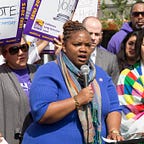What Biden’s Care Plan means for Caregivers
In previous election cycles, long term and senior caregivers have taken the back seat to other pressing issues. This year, with the Covid-19 pandemic disproportionately threatening seniors and individuals with pre-existing conditions, long term caregiving has been given a spotlight among candidates and policymakers when Presidential Candidate Joe Biden announced a $775 billion plan to boost the caregiver economy. The long term caregiving industry has long been the lynchpin to how seniors and the disabled receive care all while being able to remain safely in their own homes however, these workers are overlooked when policymakers debate healthcare policy. In order to keep up with the demand for home care services and the general preference for aging-in-place, it is estimated that the home care industry will need to fill at least 4.2 million more caregiver jobs by 2026.
Biden’s 10-year plan lays the groundwork for how the caregiving industry, primarily made up of women and people of color, would support dramatic changes in the way older adults are cared for in the United States. With so much at stake in the 2020 election, it is encouraging to see caregivers and elderly Americans prioritized and recognized on the campaign trail.
Not only have caregivers been largely ignored by mainstream campaigns, but they have also been faced with dangerous working conditions throughout the pandemic lacking personal protective equipment to do their jobs safely. They’ve also been without living wages and benefits to further care for themselves and their families. In California, the average hourly income of a homecare worker is $13.49 with an average annual income of $28,059 if working full-time hours. This has led to a lack of access to training, inconsistent dispersal of PPE, and disparities in tracing and testing during the pandemic.
We are already behind on ensuring that long term caregivers are provided the proper wages, benefits, and tools to support those they care for and live a successful life. Lack of training opportunities and low wages deter young adults from pursuing a career in home care, leading to a shortage in caregivers. Over the next 10 years, the state of California alone will look a lot different. It is expected that California will need between 600,000 and 3.2 million caregivers by 2030 in order to meet the growing demand for homecare services. Furthermore, by 2030, more than one million California seniors will need assistance with Activities of Daily Living (ADLs) and long-term care services and supports (LTSS).
The ambitious proposal will create millions of new, and more appealing, home care jobs for those looking to enter or reenter this vital workforce. Vice President Biden’s plan will take a look at caregiving’s infrastructure as part of a broader plan to build back a better economy by expanding services and to incentivize more families to fully participate in this workforce. While there are more than 600,000 IHSS and private homecare agency workers in the state, there are an even greater number of unpaid caregivers providing these services. In 2017, family caregivers in California provided four billion hours of care — worth an estimated $63 billion — to their parents, spouses, partners, and other adults.
The plan will create workforce standards that increase pay, provide benefits, and give upskill training opportunities allowing workers to expand their credentials. Existing gaps may be filled throughout the national health infrastructure with a $450 billion investment to create an estimated 150,000 new jobs to eliminate the 800,000 person waiting list for long term care.
To achieve this plan, the administration would roll back unproductive and unequal tax breaks for real estate investors with incomes over $400,000. An effort to put money back in the pockets of American families that feel the strains of our unequal economy everyday. For caregivers that have been left stagnant and unrecognized for years, this plan provides a long-deserved lifeline and while we have a long way to go, we are beginning to lay the groundwork for a better future.
